  From left, Erik Olds, Oak Ridge Office of Environmental Management (OREM) deputy manager; Jay Mullis, OREM manager; Brandon Bishop, North America’s Building Trades Unions (NABTU) secretary-treasurer; Sean McGarvey, NABTU president; Ken Rueter, UCOR president and CEO; William “Ike” White, EM senior advisor; and Jeff Avery, EM principal deputy assistant secretary.
WASHINGTON, D.C. — Efforts to retain and recruit skilled construction trade workers took a major step forward with the signing of a project labor agreement (PLA) between Oak Ridge Office of Environmental Management (OREM) contractor UCOR and North America’s Building Trades Unions (NABTU).
It marks EM’s first-ever agreement with a national labor organization, allows for flexibility in wage increases and other incentives, and establishes a template other EM cleanup sites across the DOE complex can use.
Top leadership from EM headquarters, NABTU, OREM and UCOR were on hand to celebrate the signing March 20.
“We’re very pleased about the development and signing of this project labor agreement between UCOR and NABTU,” OREM Manager Jay Mullis said. “The primary driver behind our sustained success has been the men and women in the field performing the work. This agreement will help UCOR retain this outstanding workforce, and it provides the means to ensure workers receive the pay and benefits that match their performance.”
 Approximately 550 trade workers support EM cleanup contractor UCOR in Oak Ridge. Among their many tasks are operating equipment on some of the largest cleanup projects at the East Tennessee Technology Park and conducting demolitions that are transforming the Y-12 National Security Complex and Oak Ridge National Laboratory.
Approximately 550 trade workers support EM’s Oak Ridge cleanup. They’ve achieved notable successes, including a world first by removing Oak Ridge’s uranium enrichment complex.
More recently, they demolished the Biology Complex, Old Criticality Experiment Laboratory, Bulk Shielding Reactor and Low Intensity Reactor, and they’ll conduct more projects to transform the Y-12 National Security Complex and Oak Ridge National Laboratory and enable new growth in the years ahead.
“We rely on the talent and commitment to excellence that is constantly exhibited by these workers,” UCOR President and CEO Ken Rueter said. “They enable us to safely and efficiently meet our commitments to DOE as we continue Oak Ridge Reservation cleanup activities.”
The agreement replaces a construction labor agreement previously in place. That agreement was with local building trades and limited UCOR’s ability to adjust wages to remain competitive in today’s labor market. That disparity resulted in an attrition rate of more than 20% for craft workers at the company in recent years.
The pact offers a 20% wage increase over a three-year period plus paid holidays, a contract ratification bonus and a retention incentive program. It also ensures jurisdictional issues are resolved by national union leadership.
“The signing of this decade-long PLA ensures that in the years to come, our 550 members whom it impacts will not only see the benefit of middle-class sustaining union wages but will be a critical part of our national environmental management cleanup efforts,” said Sean McGarvey, NABTU president. “Furthermore, this historic agreement is the first PLA compliant with President Biden’s executive order on PLAs. Today's signing celebrates workers, environmental management and economic opportunity for Oak Ridge and the hardworking UCOR community.”
Read more about President Joe Biden’s executive order on use of PLAs for federal construction projects here.
-Contributor: Wayne McKinney
 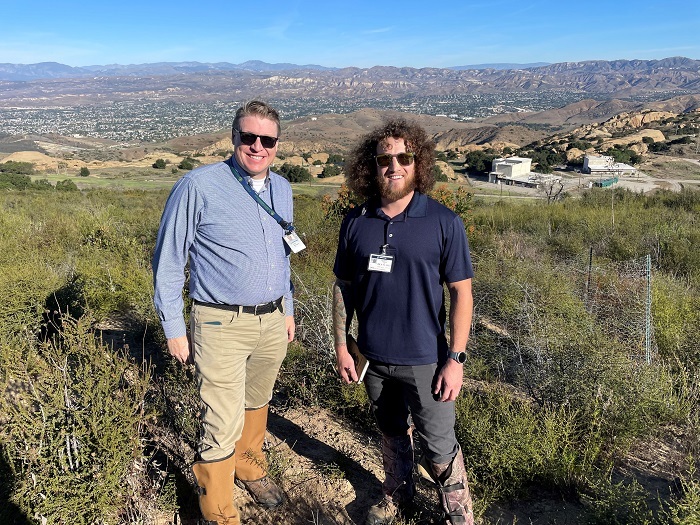 Alex Walters, right, a fellow in biology granted through EM’s graduate fellowship program at the Oak Ridge Institute for Science and Education, visited the Energy Technology Engineering Center’s (ETEC) portion of the Santa Susana Field Laboratory in January. Walters is pictured at the site with Josh Mengers, EM’s federal project director for ETEC.
Alex Walters investigates whether animals are affected by past activities at Santa Susana Field Laboratory
SIMI VALLEY, Calif. – Did historical research activities at EM’s Energy Technology Engineering Center (ETEC) at the Santa Susana Field Laboratory (SFFL) impact the animals that called it home?
That’s one of the questions Alex Walters, an earth scientist working for the Pacific Northwest National Laboratory (PNNL), hopes to find out as part of his research fellowship with ETEC.
Santa Susana is a nearly 2,850-acre site located in eastern Ventura County, California, about 30 miles southeast of Los Angeles County. It was previously used as a rocket engine testing and nuclear research facility. ETEC is located on about 90 acres in the 290-acre Area IV, which is leased and managed by EM.
Walters began his fellowship in October to work on a biological conservation project as part of the EM Minority Serving Institutions Partnership Program (EM MSIPP). The program provides science and engineering students and graduates with an opportunity for training and mentorship through an Oak Ridge Institute for Science and Education fellowship in targeted technical areas of interests and needs of the EM workforce.
 |
|
During his visit to the Santa Susana Field Laboratory in January, Alex Walters spotted a Botta’s pocket gopher, an example of mammals that either live at the site or use it as part of a wildlife corridor within EM's Energy Technology Engineering Center Site. |
Alex Walters saw a bobcat while working on an Energy Technology Engineering Center biological conservation project as part of the EM Minority Serving Institutions Partnership Program. He was there to gain insight on mammal species that use wildlife corridors by collecting scat as part of his research project. |
|
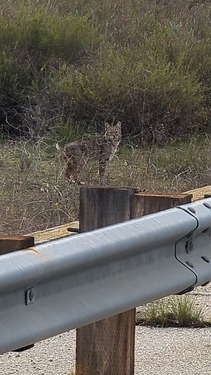 |
In January, Walters visited SSFL to gather further insight on mammal species inhabiting wildlife corridors within the ETEC Site by collecting scat from targeted species for laboratory analysis to assess potential uptake of contaminants.
Walters said the January visit was a “reconnaissance trip to get the scoop on the scat,” with the goal of answering two questions: What scat is found at SSFL, and is there enough at each site to collect for sampling?
Joined by Tara Schoenwetter, a senior ecologist with Leidos, Walters spent the week surveying areas of interest both onsite and offsite, collecting and documenting anything related to scat.
“I was pleasantly surprised with finds during our surveying efforts,” Walters said. “Also, Dr. Schoenwetter and I got the distinct privilege of being visited by a pocket gopher and seeing a bobcat.”
Schoenwetter, who has worked at Santa Susana since 2011 and developed a list of projects over the years aimed at better understanding the ecological community, said Walters’ project will help provide insight on the movement of specific chemicals through wildlife species.
“Alex’s research will help us understand the health of the wildlife population, and better understand wildlife movement across Area IV and the Northern Buffer Zone, since the entire SSFL is known to be an important wildlife corridor,” Schoenwetter said.
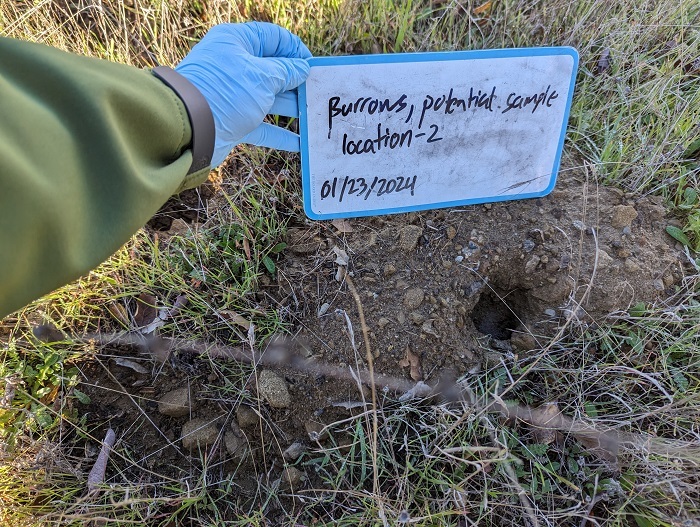 Pictured is an example of a possible burrow site at the Santa Susana Field Laboratory that could provide insight into mammal species that use wildlife corridors within EM's Energy Technology Engineering Center Site. The information collected would be part of a research project by Alex Walters, an earth scientist working for the Pacific Northwest National Laboratory.
Josh Mengers, EM’s federal project director for ETEC, said Walters’ research is an important part of biological preservation as EM works toward completing cleanup at SSFL.
“I couldn’t be happier with Alex’s research. His work will help us to understand if any contamination at ETEC is affecting the local wildlife,” said Mengers, who is also Walters’ DOE mentor for the project. “Alex is a sharp and motivated new graduate and EM is lucky to have bright folks like him participating in the EM MSIPP graduate fellowship program.”
Schoenwetter echoed Mengers, adding that it’s “been an absolute pleasure working with Alex. He is a wonderful asset to our team, and I am excited to learn about our findings.”
For Walters, he said he’s excited to continue working with mentors like Mengers, Schoenwetter and Amoret Bunn, an environmental engineer at PNNL, all while immersing himself in “the ecological uniqueness of ETEC.”
“Being able to go out and experience the biological and cultural significance of the site has been invaluable to me,” he said. “Continuing to learn about the different plant and wildlife communities and their ecological importance is exciting to me.”
-Contributor: Melissa Simon
 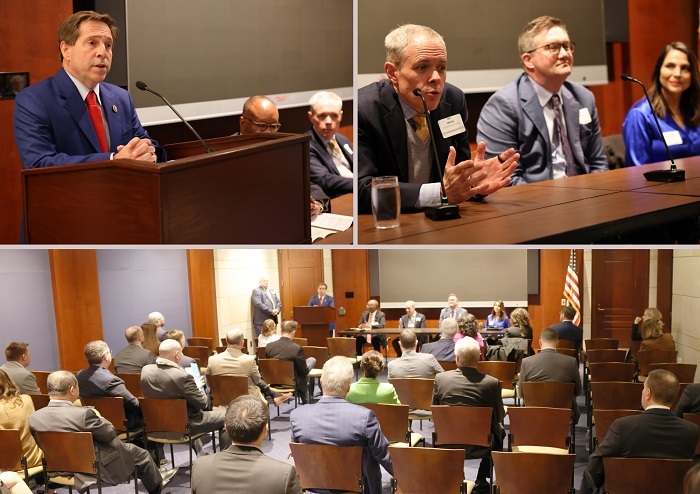
WASHINGTON, D.C. — U.S. Rep. Chuck Fleischmann of Tennessee, pictured top left, gave remarks last week at the U.S. House Nuclear Cleanup Caucus, which focused on small business contributions to EM’s success. EM Senior Advisor William “Ike” White, at top right, joined panelists Martin Schneider, president, Longenecker & Associates, and Susana Navarro, founder, president and CEO, Navarro Research and Engineering, to highlight EM’s current work with small businesses and the resulting achievements. Looking to the future of EM’s work with these companies, White said, “There’s a lot of work to do and if we’re going to get that work done faster and if we’re going to do it effectively, we need innovative ideas to make it happen, and one of the best places to get that is small businesses.” U.S. Reps. Susie Lee of Nevada and Joe Wilson of South Carolina also spoke at the event, which was hosted by the Energy Facility Contractors Group, Energy Technology and Environmental Business Association and Nuclear Energy Institute.
-Contributors: Carly Howard, Matt Roberts
 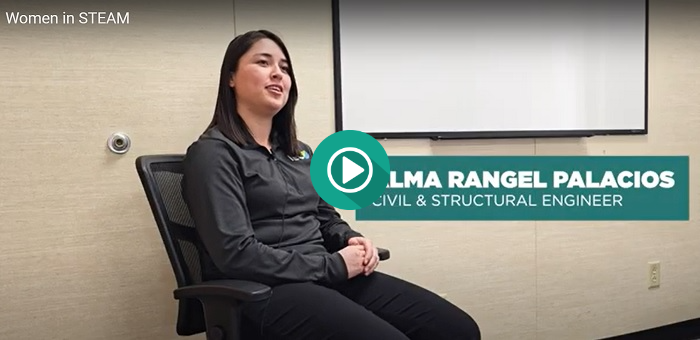
IDAHO FALLS, Idaho — Women in science, technology, engineering, art and math (STEAM) fields bring a broad range of talents, skills and perspectives to EM cleanup projects across the DOE complex. Contributions from women have helped shape the future of the Idaho Cleanup Project (ICP) while inspiring younger generations of women to join the mission. Idaho Environmental Coalition (IEC), EM’s cleanup contractor at the Idaho National Laboratory Site, spotlights four exceptional women who excel in their careers at ICP. Spent Nuclear Fuel Facility Manager Pat Spaulding, Spent Nuclear Fuel Engineering Manager Kristen Mortensen, Senior Radiological Control Technician Melissa Madison and Civil and Structural Engineer Alma Rangel Palacios share their professional journeys and achievements at ICP in this video:
-Contributor: Alessandra Hoskins
  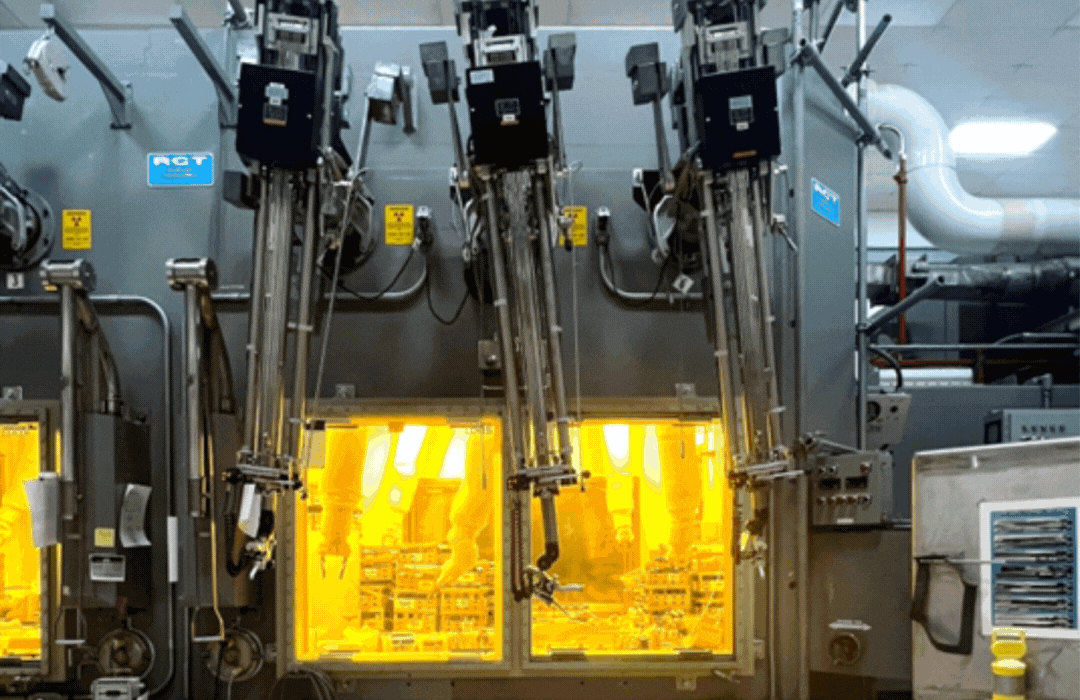 This series of photos highlights work to replace original oil-filled “hot cell” shielded windows at the Hanford Site’s 222-S Laboratory, as shown in the first photo. In the second photo, crews wear protective equipment and work in radiation containment tents while they replace the hot cell windows. In the third frame, old window glass is removed, wrapped and ready for disposal. The final photo provides a view of the new windows installed in the hot cells.
RICHLAND, Wash. — Upgrades are under way to prepare the 222-S Laboratory for the next evolution in the Hanford Site cleanup mission, treating tank waste under the Direct-Feed Low-Activity Waste (DFLAW) Program.
Operated by contractor Navarro-ATL, it’s the primary onsite lab for analyzing radioactive samples to support Hanford’s risk-reduction and tank-waste operations.
“Multiple contractors and facilities are working as a single enterprise to prepare for treating tank waste 24/7 and progressing risk-reduction projects,” said Delmar Noyes, EM assistant manager for Tank Waste Operations. “Our One Hanford team remains committed to delivering strong taxpayer value by advancing projects that reduce risks to our workforce, our community and the environment.”
The lab was built in the 1950s to support plutonium production and was converted to a high-level waste laboratory in the 1990s, following the Cold War.
Navarro-ATL is upgrading radiation containment rooms called “hot cells” that protect lab personnel while they receive and analyze radioactive waste samples. Navarro-ATL analyzes air, liquid, soil, sludge and biological samples at the lab.
The word “hot” refers to radioactivity. The “cells” are square enclosures with thick walls. Workers look through leaded glass windows with multiple layers of glass, some as thick as five inches, while they use manipulators to handle samples and equipment. The glass layers create a “sandwich” with mineral oil in the middle that clarifies the view inside.
Some of the widows began leaking oil due to their age, requiring an upgrade. The contractor has been replacing the windows in hot cells with new non-oil-filled windows that have an extended life of approximately 20 years. So far, they have replaced four of the 10 heavy windows.
Since the hot cells contain radiation, it’s no small feat to remove multiple windows weighing approximately 11,000 pounds from a contaminated area, disassemble the windows, and maneuver them through a confined pathway for removal. The team rolled in window replacements, placed them in a containment tent and lifted them into place.
“Safely replacing the hot cell windows is an important project for the laboratory to maintain mission support,” said Will Pickett, laboratory projects director. “We also balance this work with analytical priorities in the same facility, because samples are being received while this project is underway.”
In preparation for the window replacement, Navarro-ATL used multiple tools to analyze the hazards, including worker feedback. The contractor did mock-up demonstrations with the window vendor and proficiency demonstrations.
The contractor will continue replacing hot cell windows at the 222-S Laboratory through the summer.
-Contributor: Tracie Arnold
 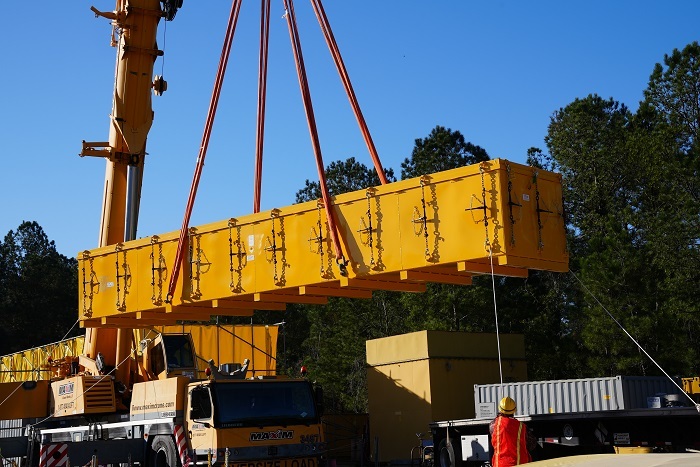 With the help of a large crane, workers carefully place a drill string container on a flatbed truck. The truck left Savannah River Site, bound for a licensed facility for commercial treatment and disposal of the used equipment. Shipments are planned for the disposal of additional equipment that remains at the site.
AIKEN, S.C. — EM has shipped legacy cleanup equipment to an offsite disposal facility after storing some of it at the Savannah River Site (SRS) since 2006.
Examples of the equipment include a column of drill pipe, known as a sampling drill string, which was used to collect reprocessing waste samples from an underground radioactive waste storage tank; bubblers used to increase efficiency of operations to immobilize the waste in glass at the Defense Waste Processing Facility (DWPF); and glass pumps that were used before being replaced by the bubblers.
Shipping of the used equipment was made possible by the 2019 interpretation of the high-level waste definition by DOE. The goal of the interpretation is to classify waste according to its radiological characteristics, rather than the waste’s origin, so that it can be properly disposed of. In 2020, the first time the interpretation was used, EM packaged and shipped DWPF recycled wastewater to a licensed facility for commercial treatment and disposal.
 |
|
A team of Savannah River Mission Completion workers secures a used drill string into a shielded box for transport to a disposal facility. |
Savannah River Mission Completion (SRMC), EM’s liquid waste contractor at SRS, properly packaged the sampling drill string in a transport container and sealed it for shipment. EM sent the container to a disposal site outside of South Carolina. This first shipment left the site earlier this month.
Future shipments of used bubblers and pumps will continue as DWPF pours glassified, high-level waste into canisters for safe, long term storage and disposal. The facility replaces bubblers approximately every six months.
According to EM, removing this equipment from SRS to a disposal facility outside of the state would have no significant environmental impacts and does not constitute a major federal action.
Jim Folk, DOE-Savannah River’s assistant manager for waste disposition, said the most important goal of this effort is to safely move the equipment for disposal.
“By moving this equipment that has completed its purpose within the Liquid Waste Program from SRS and from the state to its permanent disposal location, we are making strides to better protect our surrounding communities and our workers,” Folk said.
SRMC President and Program Manager Dave Olson said the company’s workforce is performing well to ensure the equipment is safely packaged and readied for transport.
“Our team developed a strict procedure for managing the waste throughout this process,” Olson said. “We adhere to our plan and take all necessary steps to execute the packaging, storing and safe transporting of this equipment. This project is an important step as we properly dispose of the used equipment that has helped move the Liquid Waste Program forward.”
-Contributor: Jim Beasley
 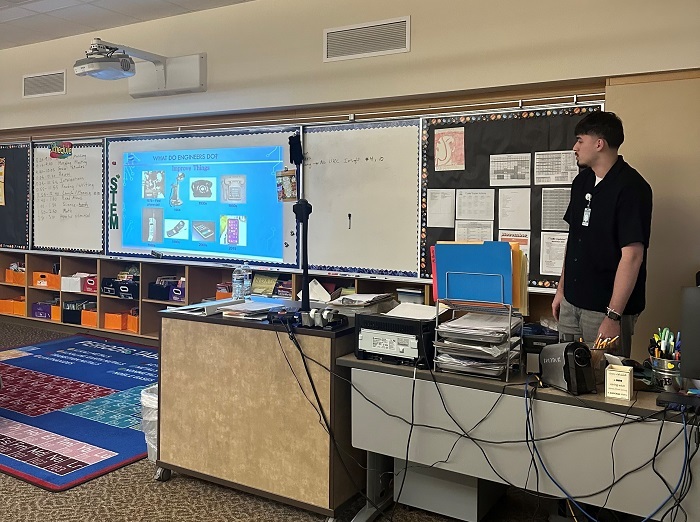
RICHLAND, Wash. — The Hanford Site workforce has a positive effect on the local community through volunteerism. Omar De La Mora, pictured, an engineer with EM contractor Washington River Protection Solutions, recently discovered that volunteering was a way for him to give back to the community. De La Mora heard his company needed a volunteer to present to bilingual English- and Spanish-speaking fifth graders for Engineers Week, an annual outreach campaign in which Hanford professionals visit local schools and encourage students to consider science, technology, engineering and math (STEM) concepts and careers. Despite a lack of experience working with children, De La Mora offered to lead the presentation. He spent much of the weekend learning the fifth grade activity and translating each of the presentation slides into Spanish. When he arrived at Curie STEM Elementary School in Pasco, Washington, he learned there were two Spanish-speaking classes, and the students in one of them spoke little English. Nonetheless, he led both through the planned event. In doing so, he showed his dedication to helping foster a diverse and well-educated future engineering and technical workforce. De La Mora said his first classroom talk with local students about engineering and science made a profound impression on him.
|




